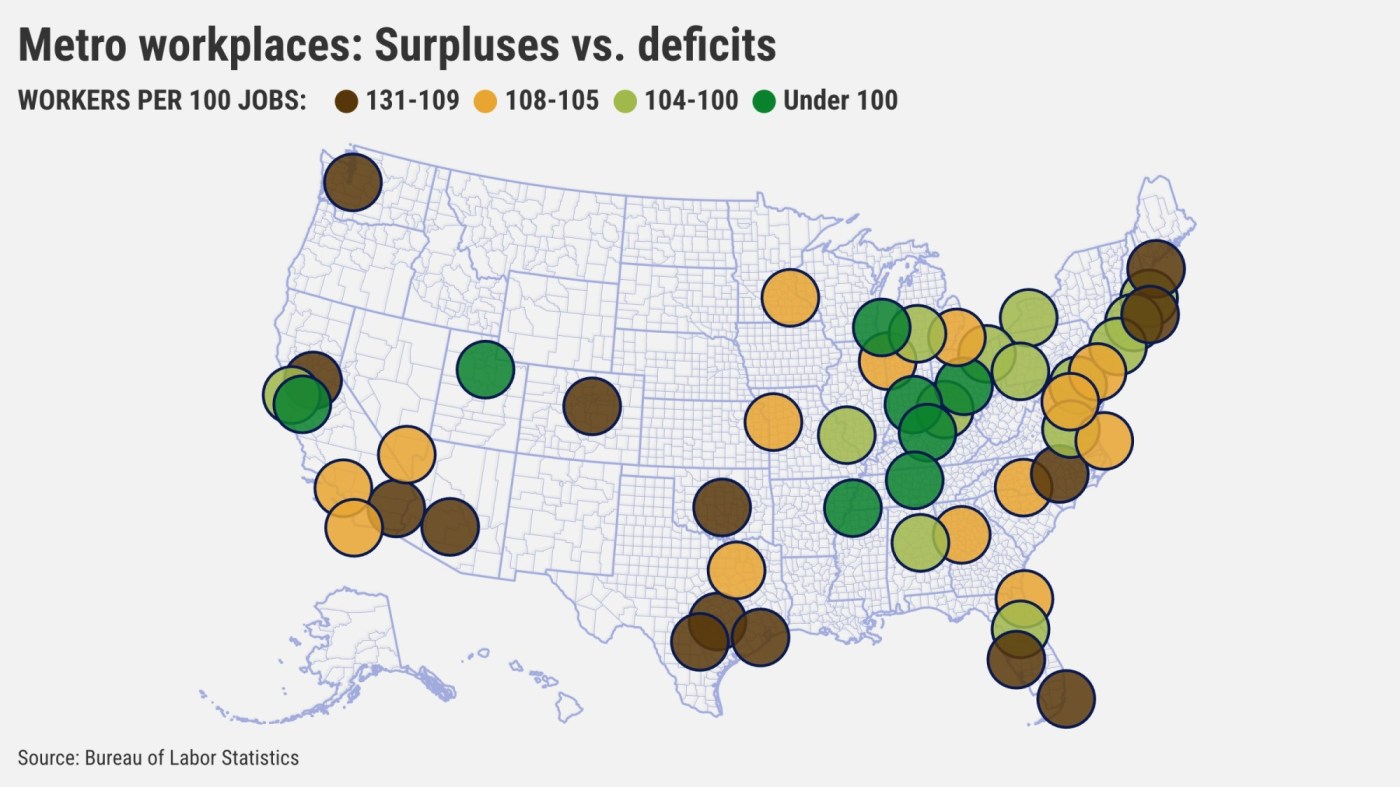Could anything be more different than the workplaces of the warehouse-centric Inland Empire and tech-driven San Jose?
You see, the regions rank as two of the nation’s oddest job markets. That’s not for their employment specialities but rather a curious workplace gap fueled by housing affordability.
Let me explain. My trusty spreadsheet contrasted two slices of April employment data for the 50 largest metropolitan areas, including six in California.
First, there’s the number of workers in a region, derived from a survey of households seeking to know who’s got work. Then, there’s the number of jobs in a market, based on a poll of employers that gauges local staffing.
If you look at the spread between those numbers, you see that the Inland Empire and San Jose metros stand out nationally – but in very different ways.
Inland view
Let’s begin with the metro comprising Riverside and San Bernardino counties.
The Inland Empire has 2.2 million workers but only 1.7 million jobs. That leaves a 531,000 worker surplus – or 131 for every 100 local jobs. Both measurements are the highest in the nation for this workplace mismatch.
How can there be such a wide gap? Yes, there are some geeky statistical quirks in play between the two employment counts. And remote work is part of this equation, too.
However, the biggest factor is seen in rush hour traffic. Most surplus workers can be found crowding freeways every workday, leaving the Inland Empire for jobs in coastal employment hubs.
Why drive? Think about house prices in the first quarter, courtesy of the National Association of Realtors.
The Inland Empire’s $609,000 median price tag isn’t cheap, but it’s a relative bargain compared with neighboring markets – Los Angeles County is $863,000, San Diego County $1.04 million and Orange County $1.45 million.
Don’t forget the pay scale. The Inland Empire’s median wage for a job last year was $48,000 vs. $53,000 in the Los Angeles-Orange County metro or $57,000 in San Diego.
It’s a grand example of how housing affordability tweaks demographic patterns.
Bay Area divide
Next, contemplate the San Jose metro comprising Santa Clara and San Benito counties.
This region has 1.06 million workers but 1.15 million jobs. That’s an 82,100 deficit, or 93 workers for every 100 jobs.
Both yardsticks rank as the second-largest shortfalls among the 50 big metros. Only Salt Lake City’s 99,000 shortage – 88 workers for 100 jobs – was wider.
Again, think jammed freeways and costly housing.
San Jose is the nation’s most expensive spot to buy a house, with a median price of $2 million. That makes the nearby San Francisco metro’s $1.32 million price or $955,000 in Salinas seem palatable.
Or consider the not-so-far-away Sacramento metro area. It’s got the 10th largest worker-to-jobs surplus, a ratio of 110 per 100. That’s from 1.2 million workers vs. 1.1 million jobs – or a 105,500 gap.
Sacramento’s surplus can be viewed much like the Inland Empire’s spread: think housing. Sacramento’s got a budget-friendly $550,000 median house price.
And remember, a major San Jose draw for workers is the paycheck. The metro’s $82,000 median wage in 2024 was No. 1 in the nation and tops San Francisco’s $74,000 or Sacramento’s $59,000.
Other gaps
The job market covering Los Angeles and Orange counties had the 16th largest surplus, 107 workers for 100 jobs. The nation’s second-largest employment hub’s 6.74 million workers outnumber 6.28 million jobs, or a 452,500 surplus.
San Diego County also has 107 workers for 100 jobs. That’s 1.68 million workers vs. 1.57 million jobs – a 108,500 surplus.
And San Francisco ranked No. 32 at 104 workers for 100 jobs. Its 2.51 million workers tops the 2.42 million jobs, or an 88,000 surplus.
Among the big 50, the largest employment surpluses possess a deep Texas accent. After the Inland Empire comes Providence, Rhode Island, with 122 workers for every 100 jobs. Then comes San Antonio (114), Houston (113), and Austin (112).
Conversely, San Jose and Salt Lake City were two of only eight big 50 job markets with employment deficits.
The others were decidedly Middle American towns where many workers commute from outside the metro area into the “big city” for work: Milwaukee (94 workers for every 100 jobs), Memphis (96), Indianapolis (98), Louisville, Kentucky, (98), Nashville (99.5), and Columbus (99.97).
Jonathan Lansner is the business columnist for the Southern California News Group. He can be reached at [email protected]
Related Articles
More housing units slated for Westport development
Single family residence sells in Pleasanton for $1.8 million
The 10 most expensive homes reported sold in Los Gatos in the week of April 21
Single-family home sells in Danville for $1.7 million
Single-family home sells in Los Gatos for $1.1 million





